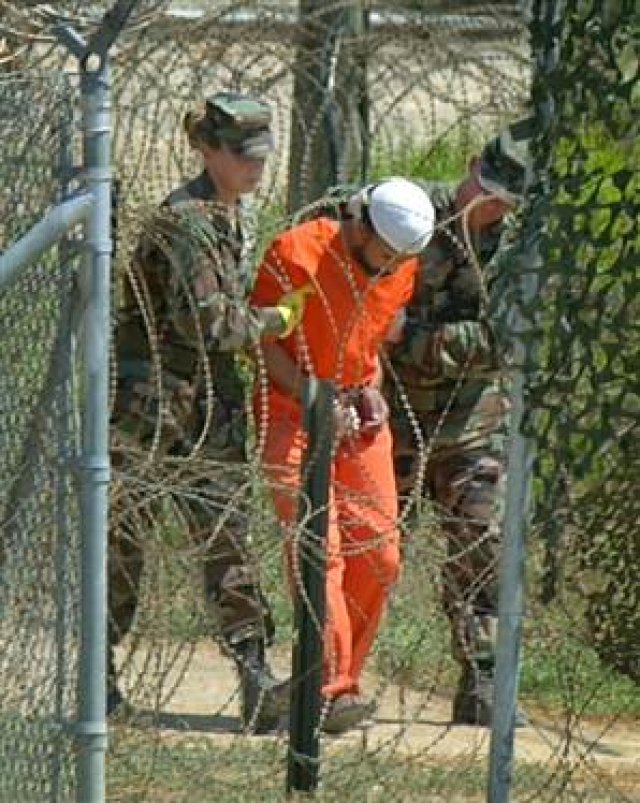
The release of secret US Department of Defense files on prisoners held by the US as part of the “war on terror” confirms, in the US government’s own words, the shoddy and unreliable nature of the “evidence” used to condemn prisoners at its Guantanamo Bay torture camp.
The files released by WikiLeaks also show the mentality of the US government in its attempts to prosecute and gather information about “terrorists” to justify its wars of aggression. Apart from those known to be innocent by their US captors, many others were condemned on the flimsiest of pretexts.
A number of files contain the line: “background notes are based solely on the detainee's statements”, neglecting to mention that these “statements” were made in an environment of constant torture and threats.
Other “evidence” came from fellow detainees who “were subjected to torture or other forms of coercion” or who “provided false statements to secure better treatment in Guantanamo”, WikiLeaks.ch said.
Among the torture methods used were prolonged solitary confinement, regular and prolonged beatings, prolonged periods in stress positions, sleep deprivation, water boarding, electric shocks, injections of experimental drugs, exposure to loud music and extreme cold.
The cases of two Australians condemned to Guantanamo Bay — David Hicks and Mamdouh Habib — are emblematic of this farce.
Hicks laughed as he read the file about himself, a spokesperson for Hicks told Green Left Weekly.
The five-page assessment of Hicks’ status as a prisoner, written in September 2004, contains many basic errors, as well as speculation and information extracted under torture, used to justify his detention.
Hicks’ spokesperson said in a statement: “This document shows that even back in 2004, Mr Hicks was not suspected and/or accused of hurting any person, or involved in any terrorist acts.”
Despite this, Hicks was forced to plead guilty to “material support for terrorism” in 2007 after spending more than five years in the US torture camp in order to be returned to Australia.
Hicks maintains his innocence and has never received a fair trial. Nonetheless, he has been publicly labelled one of “the worst of the worst” terrorists by the US and Australian governments.
The files’ inaccuracy on basic facts — such as Hicks’ middle name, the location of where he was captured, and the name of a US Navy ship — casts doubt on the basic seriousness and competence of the investigation.
The statement from Hicks’ spokesperson debunked 13 errors in his file. The most serious allegations included that Hicks was a “sworn fighter” for al-Qaeda, would probably become a “mercenary” if released and was a “possible leader for any extremist organization”.
Hicks’ spokesperson said: “The report alleges that Mr Hicks led in prayer and was held in high regard by other Guantanamo detainees — Mr Hicks cannot speak Arabic, and his knowledge of the religion would not qualify him to lead prayer.
“Some detainees thought that Mr Hicks was a spy, so any allegation that he was a leader is simply outrageous.”
Hicks’ spokesperson said any admissions about involvement with al-Qaeda were made under torture. Since his release, Hicks has taken up a career as a gardener, not a mercenary.
The file also falsely claimed that Hicks “flew to East Timor in order to take part in the conflict there” in 1999.

Sally Neighbour said on April 26 in The Australian that this mistake “suggests the US was confusing Hicks with another Australian, former soldier Matthew Stewart, who left the Australian army and allegedly joined al-Qa'ida after a stint in East Timor in the late 1990s.
“It is hard to imagine a more flagrant mistake in a document that purported to be the legal justification for the historic first military commission trial.”
The file relating to Mamdouh Habib tells a similar story. Along with basic errors of fact, such as incorrect place names and dates, Habib’s file cited “admissions of guilt” made “under extreme duress” as reasons for his continued imprisonment.
The “admissions” — which the file acknowledges were later retracted — included that he trained six of the 9/11 hijackers and planned to hijack a Qantas flight. The file also contains speculation that Habib was a money courier for al-Qaeda.
Habib told ABC Radio’s AM program on April 26 that he denied ever making the admissions. He also said: “I never been a courier for al-Qaeda. I never deal with al-Qaeda ...
“Because they know themselves they lied, they’re dishonest, they tried to fabricate documents.”
The file also shows Habib was tortured in Egypt before being transferred to Guantanamo Bay. Habib was released without charge in 2005 and recently received a settlement from the Australian government after he launched a lawsuit.
However, despite the highly dubious contents of the files, a number of corporate media outlets reported the speculation in the files as fact. This continued demonisation of Hicks and Habib serves to provide cover for imperialist aggression in the Arab world and to justify attacks on civil liberties as part of the “war on terror”.
The Guantanamo Bay prison remains open despite US President Barack Obama’s pre-election promise to close the camp and provide fair trials denied under former president George W Bush.
It still holds 172 prisoners, some with no prospect of trial or release, the Guardian said on April 25.
Obama has signed an order that said dozens of detainees already held for years would continue to be imprisoned indefinitely without any charges, said the March 8 Washington Post. Obama has also shielded from prosecution government and military figures accused of involvement in torture.
Comments
Anonymous replied on Permalink